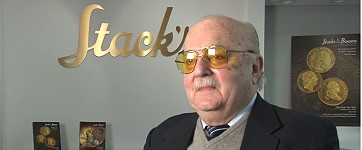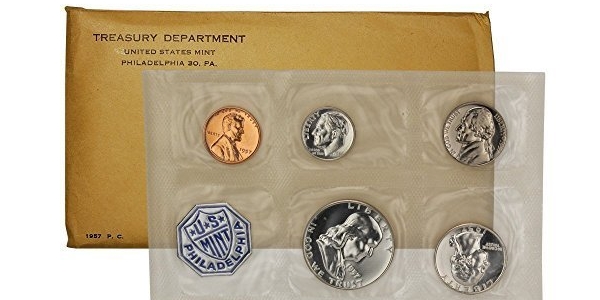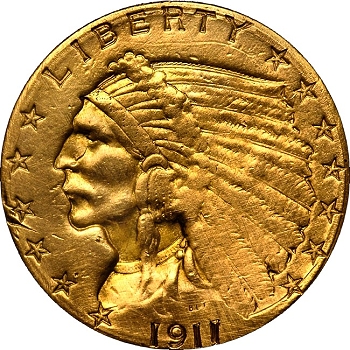By Harvey Stack – Co-Founder, Stack’s Bowers Galleries ……
Links to earlier parts: 1 | 2 | 3 | 4 | 5 | 6
An Important Year in My Development
By 1957 I had some 10 years of full-time experience at Stack’s, which exposed me to an active retail trade in coins. I also met clients from yesteryear who were currently building or selling their collections, and I also learned the art of auction catalog and price list presentations while expanding my numismatic knowledge. Being dedicated to the firm, being exposed to collectors of all series, and being part of a very good professional staff made me develop into a professional numismatist.
 The exposure I had to an active retail shop in the heart of New York City–to which collectors from the city and surrounding areas seemed to flock–provided me with a numismatic culture that would be hard to find in the 21st Century.
The exposure I had to an active retail shop in the heart of New York City–to which collectors from the city and surrounding areas seemed to flock–provided me with a numismatic culture that would be hard to find in the 21st Century.
I also attended many coin shows nationwide, and even went to Europe for some of that continent’s sales. I was trained in all series, from Ancient times through to the Modern era, in all metals and currency that were actively collected.
The Collector Is King Again
The period starting about 1957 showed a new direction and interest in the hobby of collecting. The influence for a while of the earlier years of this decade had a momentum driven by collectors but dominated by speculators for late-date Proof sets, 1936-1942 and 1950 to 1957, as well as those who felt that full Mint State rolls of current issues would grow in value. That bubble started to burst around 1957, and the cost of the more numerous collectibles dropped completely. This had an adverse effect on earlier issues of United States coins (just from 1950 to 1957 the Mint struck some 50,000 proof sets to over 2,200,000 by 1957). The Mint sold these sets at $2.10 each, and they were grabbed up by speculators as “the way to make money”.

Unfortunately, the number of collectors in the country who wanted Proof sets for their collections never reached that number, and so all those that were put away had no way of being placed in individual collections. There were always speculators who touted the value of these sets, so even if it did not take much money to own a set from the Mint ($2.10 per set), there was never enough demand for these sets to sustain their speculative supposed collector demand.
But another, more important group of factors affected the market by 1957. Collectors who had started their collections prior to World War II returned to collecting and bought rarer earlier dates of classic issues. New collectors, many of whom began collecting coins from change and housing them in low-cost albums (as low as 25 cents each), were getting interested in rarer coins and bringing their children into the hobby as well.
Also, collections that were started or existed before World War II were becoming available to the market, as those who developed these wonderful collections passed away or simply lost interest in maintaining them. So both old and new collectors had “fresh” coins to add to their collections.
Add all these factors up, and this is why the hobby returned its focus more towards collecting and away from the speculative fever of the earlier 1950s.
Named and Not-So-Named Collections
During this period of rejvenated collecting, we attracted many great collectors and numismatic legends to our store. We also worked on collections of historical note, such as upgrading some of Louis Eliasberg’s coins and developing the Josiah K.Lilly Collection of Gold Coins of the World – which included a virtually complete collection of United States Gold, a world-class collection of Spanish American gold coins, and a extensive collection of gold coins from Ancient times to the Modern period. We were busy almost every day and night, working with collectors and preparing auction catalogs while still stocking coins for sale as they were acquired over the counter.
To begin the year of 1957 with outstandings sales, we offered the J.W. Schmandt collection, which featured numerous raritities such as Kellogg and Wass Molitor $50.00 slugs; a Coiled Hair $4.00 Stella; 1796 and 1808 quarter eagles; a 1933 $10.00 gold eagle; and a run of rare-date $20.00 gold including 1926 “S & D”, 1927 “S & D”, 1930-S, 1931-D and 1932. Not to mention an extensive offering of earlier silver and copper dates and mints. The offering of this collection attracted many buyers from all over the country.
We had a few other collections thoughout the year, including the Empire collection (the collector C.A. Cass didn’t wish his name used). Started by his family in 1885, the collection featured a very choice 1792 Half Disme; an 1894-S Dime; an 1876-CC 20 Cent Piece; 1838-O, 1847/6-O and 1853-O No Arrows half dollars, and a choice 1794 silver dollar – plus virtually a complete set of dates and mints from 1793 to 1956 in Proof and Mint State Condition. Another outstanding pedigree collection.
One wonders why some of the sales were given names different from the names of those who assembled the collections. The reasons are simple. The collectors personally did not want noteriety, among family, friends or fellow collectors.They did not want to be hounded for loans. But mainly, they just wanted to collect in privacy and enjoy their hobby quietly. So we abided by their wishes and used noms de collection in order to protect the owners’ names.
The Modern Era of Gold Counterfeits Begins
The year 1957 was scarred by one factor that caused some disruption in the gold coin market.
 Coins that were looked upon as “charms” had become very popular, and overseas counterfeiters started to flood the marketplace. In the begining when these coins first appeared in jewelry stores, hock shops and even coin dealer show cases, the Secret Service tried to and did apprehend a number of distributors and their customers. Dealers like Stack’s who could readily detect these counterfeits helped identify the fakes that Secret Service agents brought to us. Many of those caught were indited and tried in federal court. Professional dealers became expert witnesses to help convict the importers. We thought for sure that our efforts would put an end to these counterfeits, but there were too few agents and too many abusers. The battle waged on for a number of years.
Coins that were looked upon as “charms” had become very popular, and overseas counterfeiters started to flood the marketplace. In the begining when these coins first appeared in jewelry stores, hock shops and even coin dealer show cases, the Secret Service tried to and did apprehend a number of distributors and their customers. Dealers like Stack’s who could readily detect these counterfeits helped identify the fakes that Secret Service agents brought to us. Many of those caught were indited and tried in federal court. Professional dealers became expert witnesses to help convict the importers. We thought for sure that our efforts would put an end to these counterfeits, but there were too few agents and too many abusers. The battle waged on for a number of years.
But from our point of view, if we helped stop the importers of counterfeits then we could give greater assurance to our clients, and therefore our business in gold coins started to grow.




